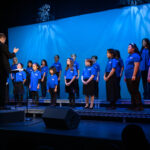
The Exhibition
We are accustomed to the figure of the artist as a protean creator, a maker of things that transcend everyday existence and provide windows into a possible world extending from a fertile, flexible mind and hand. Aganetha Dyck’s artistic practice has for decades posed challenging questions to this model. By inviting honeybees to alter both her artworks and the everyday objects that define us, she relinquishes control over the finished products that we view as emblems of human achievement. From luxurious porcelain figurines, to stiletto heels, football helmets, and the impressive craft of a lobster trap, objects of perfection are given over to the humble labours of tiny insects. And, for the duration of this exhibition, the space of the gallery will be inhabited by these guests, who are connected to the world outside by a Plexiglas tube. The work of the artist is intertwined with an ongoing project, an architecture of honeycomb that, though threatened, continues incessantly and offers its own constantly evolving model of perfection.
The bees and their work are guests in the gallery. This places them (and their impresario) in a special position as dependent, on the one hand, and as subtle transformers on the other. Free to come and go, they offer from their temporary home an encounter with a different state of being—collectively organized, following its own time, instructing and reminding us of the humble labour that keeps plants growing and nature’s cycles in play. The honeybees are, of course, workers, a category artists have often taken great pains to distance themselves from; Aganetha Dyck proposes through her work with bees that art and labour be thought together, as essentially parallel processes. Dyck calls her interactions with bees experiments in “interspecies communication.” The insects are passing us a message from elsewhere, their temporary platform as full of transformative potential as an altarpiece. It remains to be seen whether or not we will grasp it.
-Pan Wendt, curator



 About the Centre
About the Centre Support the Centre
Support the Centre Art Gallery
Art Gallery Arts Education
Arts Education Choral Music
Choral Music Heritage
Heritage On Stage
On Stage Live @ the Centre
Live @ the Centre